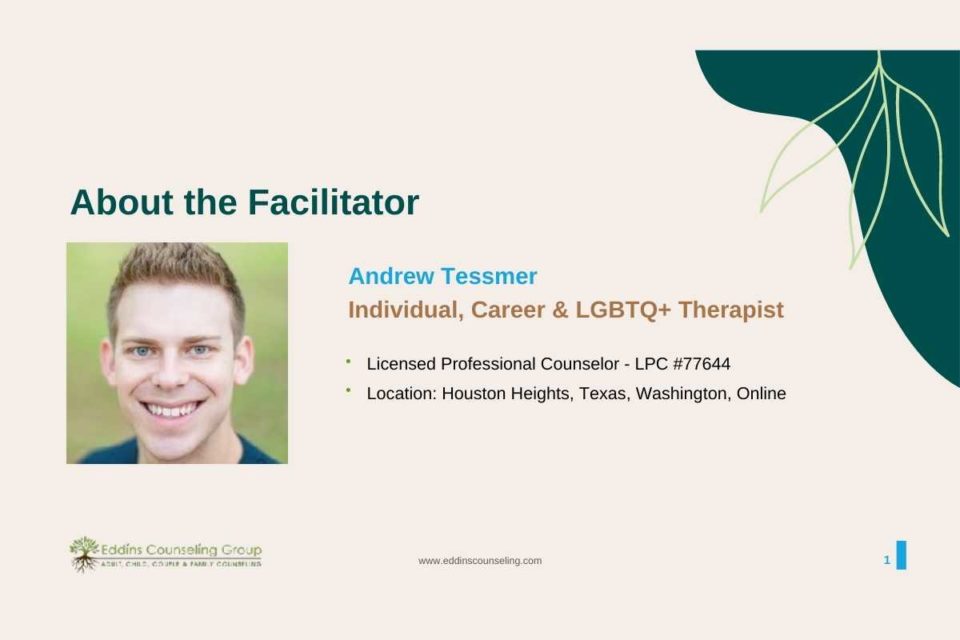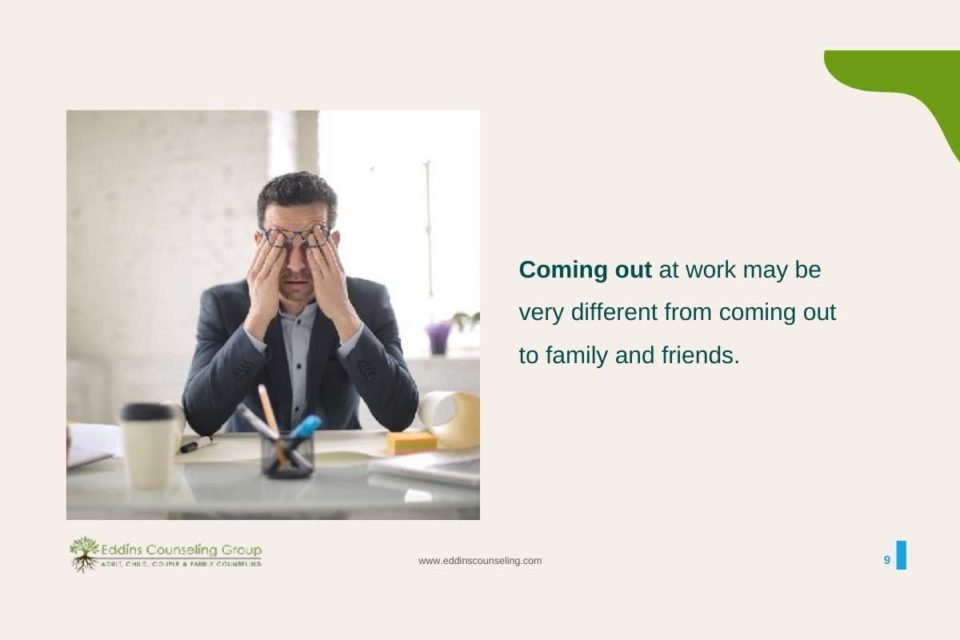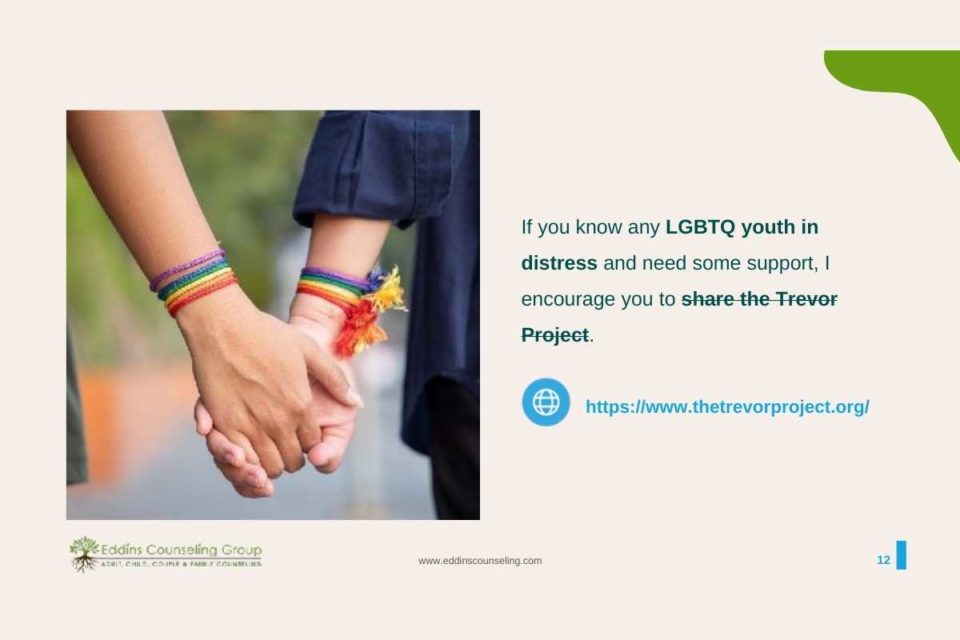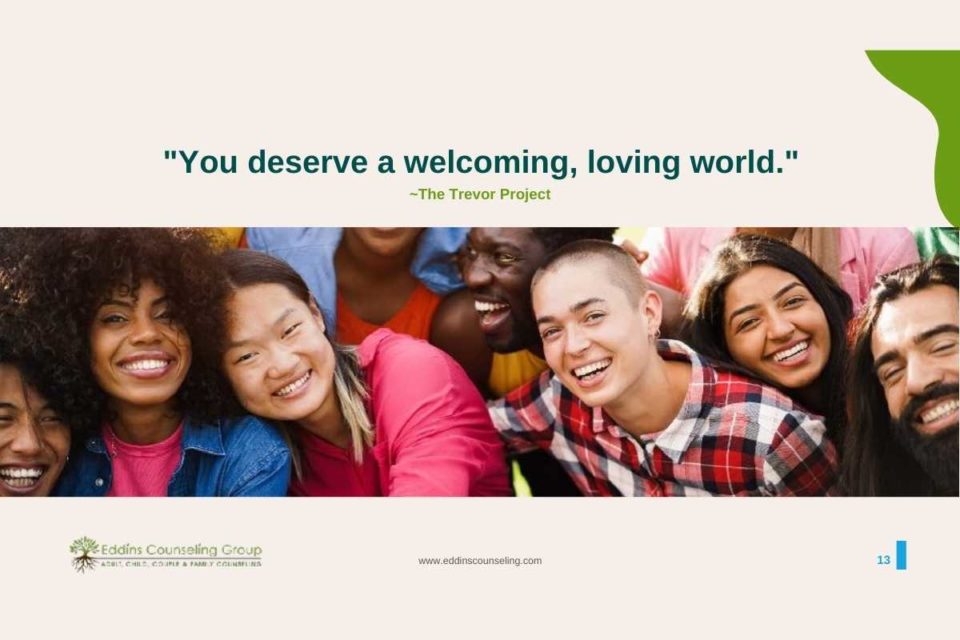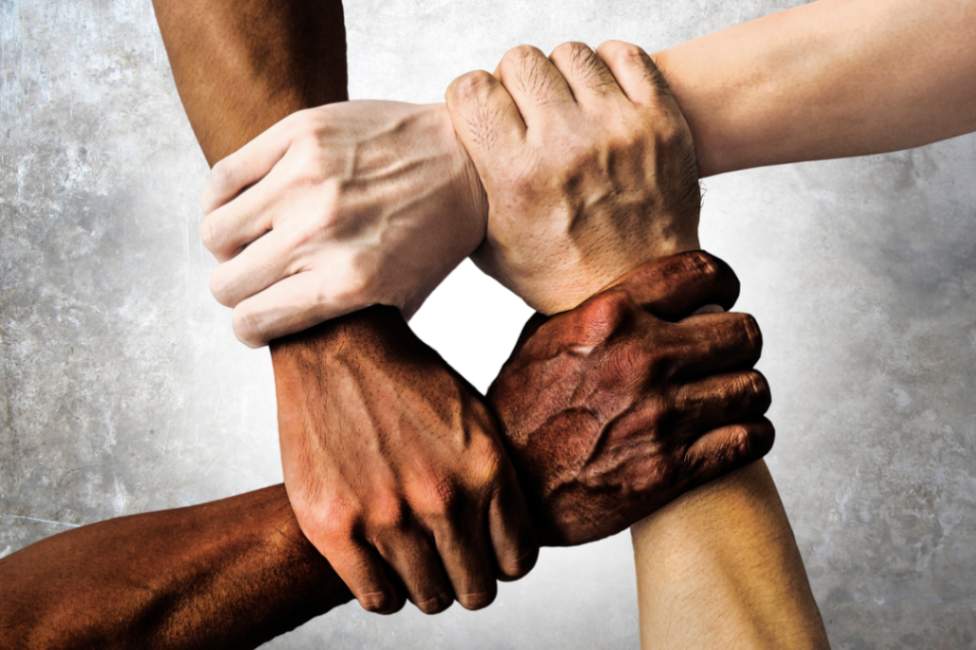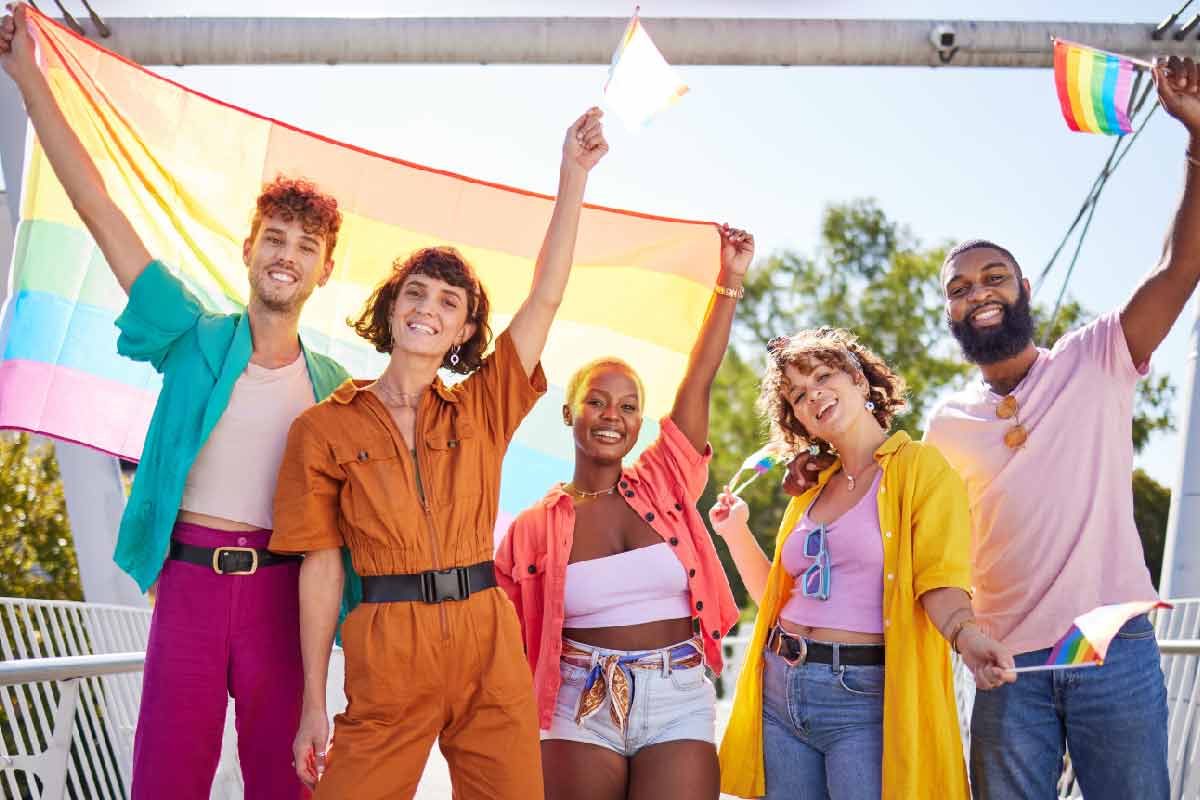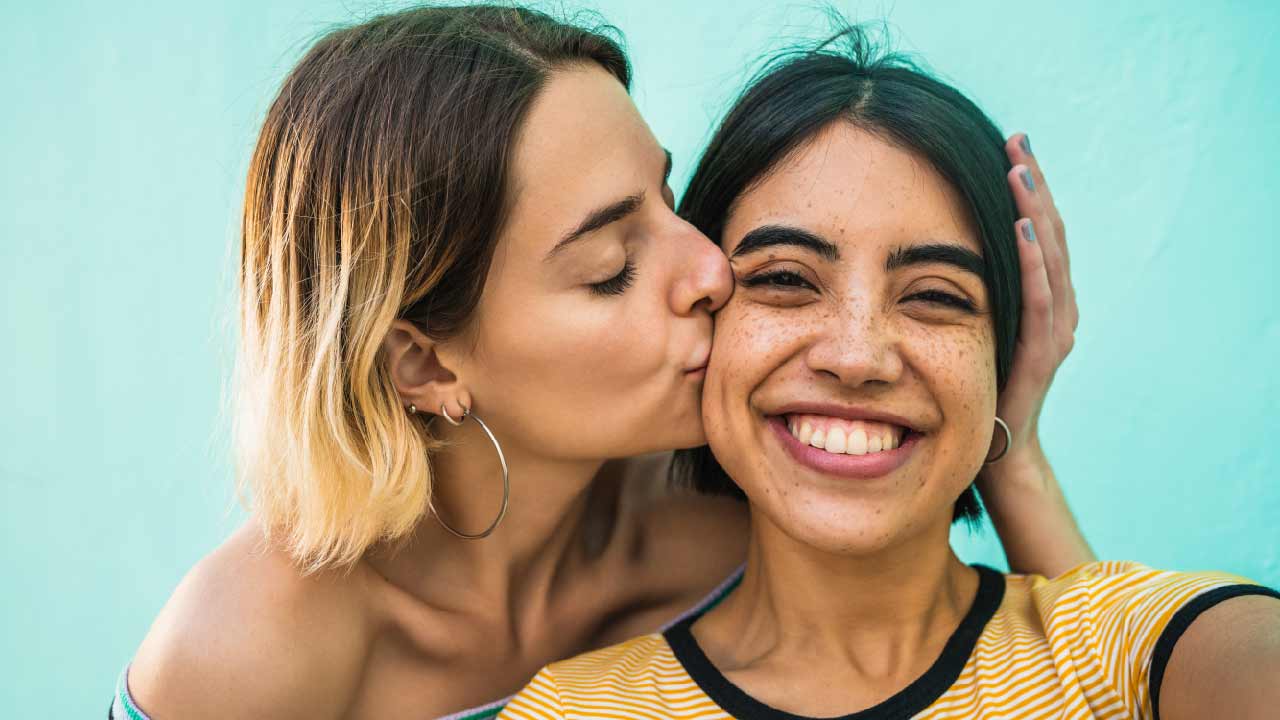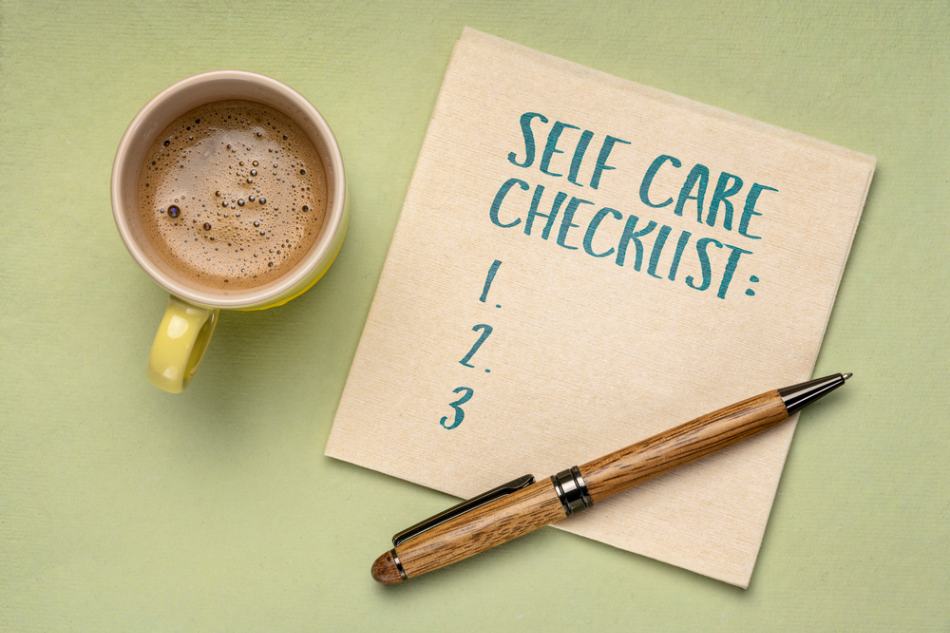June 10, 2021
Webinar: PRIDE: Providing Resources, Information, Demystification, and Education to be a supportive LGBTQ+ Ally
Written by Rachel Eddins
Posted in LGBTQ + Multicultural Concerns, Webinars and with tags: LGBTQ
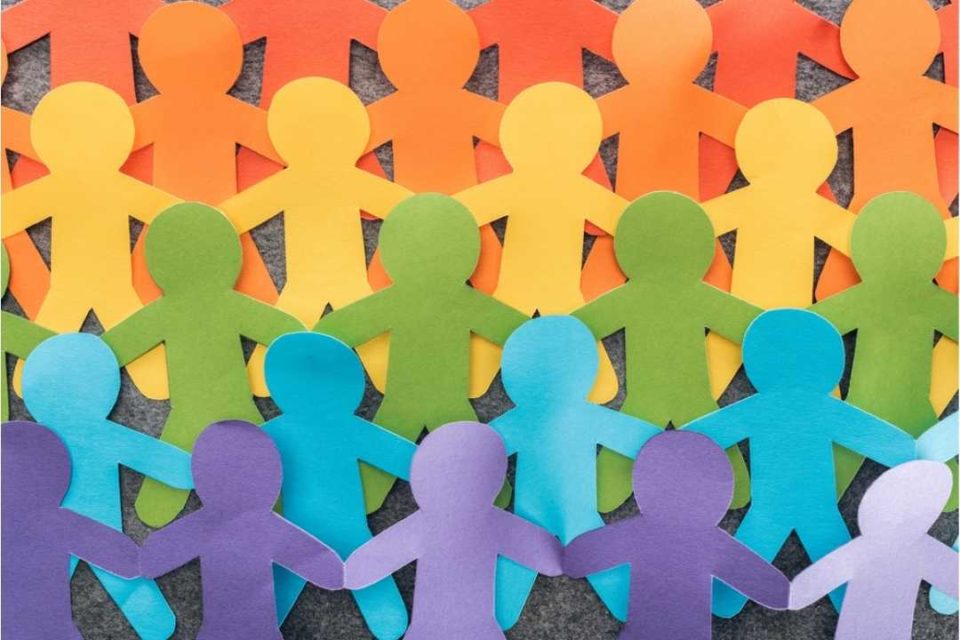
Do you know how to be a supportive LGBTQ+ Ally?
Facilitated by Andrew Tessmer, LPC.
Watch a replay of the presentation here.
Learn more about LGBTQ Counseling Services.
Here is a transcript of the webinar:
Hello! My name is Andrew Tessmer and I specialize in working with career concerns, ADHD, anxiety, and depression. One of my favorite specializations is working with the LGBTQ+ population.
This presentation is really focused on how you can go ahead and be a supportive and good LGBTQ+ ally.
I’ve structured the training today to go over some key definitions and terminology that are good for allies to know, challenges within the LGBTQ+ population that are important for allies to be aware of, and then also techniques and strategies on how you can be a good ally.
We will be recording this presentation and I will be going ahead and answering questions toward the end. And so if there are any questions along the way, please write them in the chat box and I’ll be able to go ahead and address those towards the end of the presentation.
Should take me about 45 minutes or so to finish. And at the end, we’ll be able to kind of wrap up with some questions.
So, go ahead and please add those questions in as you go ahead and have them in the chat box.
Key Definitions
Today’s focus is going to be on Pride. June is the official Pride Month, so perfect timing for this. We need to start with some key definitions that are going to be quite important for us, especially in working with the LGBTQ+ population or just kind of being a good LGBTQ+ ally.
So oftentimes people get sex, gender, gender identity, and sexual orientation a little bit confused and mixed up. I want to make sure that we are all kind of on the same page as we talk about this.
Sex
Sex is the biological, anatomical, and physiological differences between males and females. When we talk about sex, we’re talking about distinct physiological and biological differences. Oftentimes people think sex and gender are the same, but they are very different.
Gender
Gender is socially constructed and oftentimes it’s socially constructed characteristics of men or women or folks that may identify in a different gender, such as norms, roles, and relationships. It varies from society to society, and gender can be changed.
When we are looking at world civilizations throughout time, we’ll also notice that oftentimes many civilizations have more than just two genders and genders, not often in some cultures related to biological sex.
It’s really important that when we think of gender, it’s something that’s a lot more flexible. It’s something that’s a lot more focused on social construction. And because of that,
Each individual’s definition of their gender and their gender identity may differ from one another.
I identify as this gender, my gender is male, but my perception of my gender as male may be very different than the perception of another male’s gender. It’s very important to understand that gender and sex are very different.
Gender Identity
Gender identity is a personal sense of one’s own gender, and it can correlate with the assigned sex at birth or it can differ from it.
Sexual Orientation
Sexual orientation is different. It’s an enduring pattern of romantic or sexual attraction to people of the opposite sex or gender, the same sex or gender, or both sexes and more than one gender. Orientation is typically about who we go ahead and like. Identity, of course, is who we are. I just want to clarify some terms there.
Coming Out
Coming out is when an individual within the LGBTQ community publicly declares their own identity, whether it’s to an individual person in private, or to a group of people. Oftentimes during Pride Month, what you’ll see is celebrities or famous folks begin to come out on social media so it can be to the global community as well.
So coming out is something that doesn’t just happen once, but oftentimes for LGBTQ folks is a constant thing that they have to go ahead and do all the time to a new employer, to a new friend, to a new in-law, etc.
It’s really important to understand that coming out is not a one-time occurrence, but one that goes throughout an LGBTQ person’s life. Oftentimes it can create a lot of different stressors and challenges emotionally in feeling like:
- Is it a safe environment?
- Is it the person I can trust to come out?
- Will this person hold that in confidence if I ask them to?
A lot of times folks that are coming out, especially if they are coming out for the first time, there’s a lot of anxiety and fear around what that may mean, not only for them but also for their personal relationships.
Closeted
Folks that are closeted oftentimes do not disclose their sexual orientation or gender identity. They may go ahead and not be ready for a variety of reasons. When we hear the term closeted, we just mean that it’s someone that has yet to disclose their orientation or identity.
Sex Assigned at Birth
When we think about sex assigned at birth, oftentimes people get a little bit confused with this term. It’s really important to understand that it’s the sex to which you were given when you were born or on your birth certificate. A lot of times, within society, folks correlate gender and sex so frequently for transgender individuals, they will use the term sex assigned at birth to create that distinction there.
When they were born, the doctor on the birth certificate looked at their genitalia and said: “Ok, well, those are traditionally male genitalia, so you are sex-designed male.” But they may not identify with that in their childhood or teen years or later in life. We’ll use that throughout our course.
The Gender Unicorn

This is a wonderful resource that I like to use in a lot of my training and also times when I’m working with parents of LGBTQ youth, that may be a little bit confused on what are some of the terminologies that their child is using with them. I’ll use it even with clients that may be navigating different areas here.
It’s a very helpful one created by Trans Student Educational Resources. They’ll have this graphic and it’s translated into many different languages. And so if you’re trying to explain these concepts to someone that it may be a little bit challenging to understand, I always recommend visual aids and so go ahead and feel free to share those.
Gender Identity
When we think of gender identity, we can see the thought bubble in the unicorn. Again, that’s one’s perception of their own gender. It can be female, can be male, can be other, can be nonbinary. It’s the way in which one perceives themselves and the way one feels that gender ties into that perception.
Gender Expression
Gender expression is the way in which they go ahead and share that gender through attire, makeup, hairstyle, and clothing choice to the outer world. When we think of that, it doesn’t necessarily always have to be in direct alignment with that gender identity. One could go ahead and identify as male, but maybe on a day to decide to wear a skirt and heels, because for whatever reason, on that day, he wants to go ahead and express his gender as female. It doesn’t mean that his gender identity is female. It’s just that he’s expressing his gender in that way.
Sex Assigned at Birth
We have sex assigned at birth, which, again, is female, male, other, or intersex. Intersex is also part of the LGBTQ community. Folks that are oftentimes born with maybe ambiguous genitalia or have some sort of a chromosomal difference. There may be ambiguous genitalia in which the doctors don’t really know what the sex assigned at birth is. And so intersex folks are a very important part of the LGBTQ community as well.
Physically Attracted to
We also have a difference in terms of sexual orientation and romantic orientation. And this is oftentimes something that even folks within the LGBTQ community aren’t always aware of. And so what do you think of folks being physically attracted to someone, oftentimes, I like to go ahead and think of that as sexual orientation. I’m sexually and physically attracted to women, men, or other genders.
Emotionally Attracted to
At times that may be the same as emotional attraction. For most folks it is, but at times it can be different. You may be romantically attracted to both genders, but maybe only physically attracted to one or the other.
Hopefully, this can help provide a little bit of a visual and a little bit of a greater understanding of some of the key differences around terminology that we just may not be familiar with, because this isn’t something that’s not really ever talked about or taught much in schools, unfortunately.
Kinsey Scale

Oftentimes people think of sexuality on a binary spectrum that you are either gay or straight, homosexual or heterosexual, or heterosexual, homosexual or bisexual. The thing is that human sexuality is significantly more in-depth and nuanced than just one or the other or bisexual.
Even though this is a little bit older, the Kinsey Scale is one that I like to go ahead and bring up from time to time to help show just that there is a difference in sexual behavior, sexual preferences, sexual desires, and sexual orientations, but don’t just fit within to a “one or the other” camp.
Oftentimes people are going to be much more towards that middle or maybe even the ones with the 5s than the 0s of the sexes. It’s really important to go ahead and have a little bit broader view of sexuality and also respect when a person does come out to you and when a person does go ahead and share their sexual orientation with you.
Take them for their word, don’t go ahead and question them as to how they know their sexual orientation, how they go ahead and feel that way.
If they feel comfortable they’ll share that with you. But it’s not your place as an ally to go ahead and question whether or not you feel like the way in which they’re expressing themselves is accurate or not.
You need to be able to understand that for a person to be able to come out to you, they’ve done a lot of soul searching and really a lot of introspection to see: Are you a safe person to whom I can go ahead and share this with? So it’s very, very important as an ally to be understanding, to go ahead and be supportive. And if they do say: “Well, do you have any questions for me? Do you have any questions about this?”, that it’s coming from a space of understanding versus questioning or judging.
Sexual & Romantic Orientations
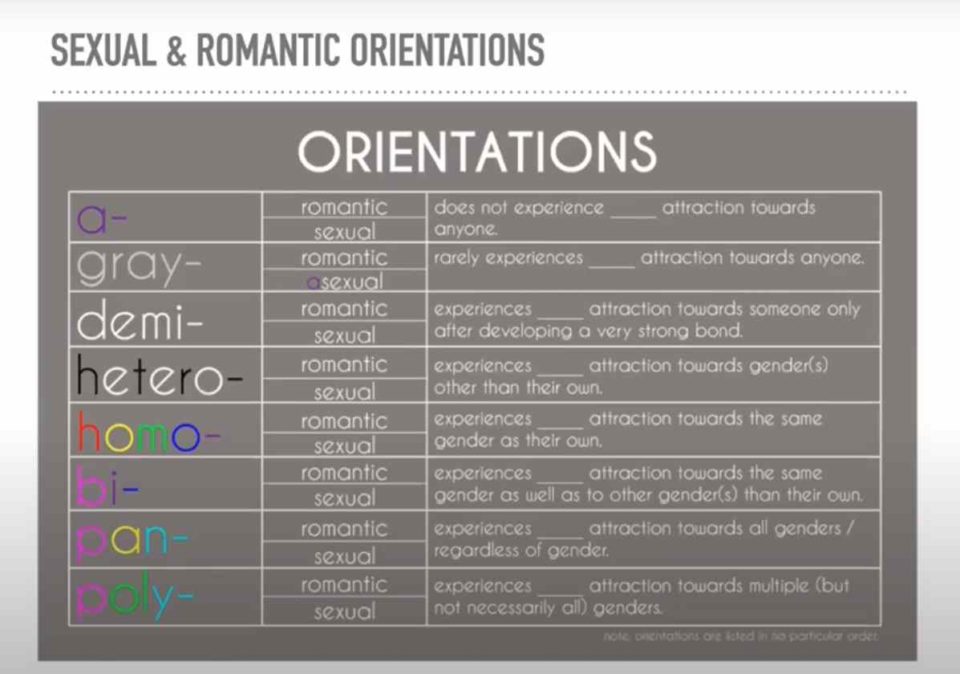
This is a helpful chart that oftentimes can be useful in understanding different types of terminology that you may not be familiar with. I’ll kind of walk through some of this a little bit with you, even though it’s kind of self-explanatory for what you see here.
We oftentimes think of asexuality as the absence of sexuality. They do not experience sexual attraction to anyone. This splits the way between the romantic and the sexual, because, again, those are different.
Asexual/Aromantic
You may have someone that’s asexual and aromantic. They don’t have any emotional attraction toward others or any sexual attraction to others.
Gray romantic/Asexual
We have folks that oftentimes are called gray romantic, typically not asexual. They typically identify as asexual with romantic, and rarely experience any kind of romantic attraction for another.
Demiromantic/Demisexual
Demi sexual or demiromantic experiences, the attraction only to someone after developing a very strong bond. Oftentimes with Dimi sexual folks, it’s not necessarily correlated with one’s gender or gender expression, but rather who that individual is.
Heteroromantic/Heterosexual
We have heterosexual folks that, you know, experience attraction towards other genders than their own.
Homoromantic/Homosexual
Homosexuals, experience attraction towards the same gender as their own.
Biromantic/Bisexual
Bi, towards typically the same gender as one other gender than their own.
Panromantic/Pansexual
Then we hear the term pansexuality and oftentimes pansexual folks or panromantic folks. It’s similar to bisexuality in some respects, but it’s a little bit more inclusive in terms of language because they’re attracted to all genders or they’re attracted to anyone regardless of their gender. Oftentimes you can some people will use Pan and Bisexuals interchangeably, but pansexual typically is a little bit more inclusive and also is focused a little bit more on folks that may experience gender outside of that buying area a little bit more.
Polyromantic/Polysexual
Polyromantic and polysexual is one that some people still use, but it’s kind of fallen out of favor a little bit. It’s experienced by multiple, but not necessarily all genders.
Definitely revisit this if there is confusion with language. And also, there are a lot of really great resources online if you’re uncertain about terminology. If you’re uncertain about what that means, do your own research. As an outline, it’s important to empower yourself to go ahead and search for this these things on your own and not rely on the LGBTQ individual in your life to have to provide you with all the information.
Now, they may be happy to do so, but that puts the burden of learning and sharing on them and not on you, the ally to whom, hopefully, if you’re here today, are wanting to understand and learn a little bit more.

Heterosexism
Heterosexism is really important to know because typically we live in a heterosexist society, which pretty much just means that there are attitudes, biases, and discrimination in favor of heterosexual sexuality and relationships.
Some of these examples are just like this automatic presumption that everyone is heterosexual. If I’m walking down the street and I’m seeing people around me, the natural inclination is that all those people are heterosexual. I may not be cognitively aware of that, but if asked.
Generally, it’s just going to be an assumption, because that’s what we’re kind of taught within society. There’s also a presumption that male and female attractions and relationships are the norm and therefore superior. This happens a lot of times in advertisements or in media in particular.
It’s important to understand that oftentimes because there’s this presumption that those relationships are the norm, superior, and then, therefore, greater represented in many different forms of media and education, family modeling, family system, and social relationships, it can be very hard for queer folks to have positive, healthy role models or positive, healthy media that shows where relationships that are considered the norm and not something to be considered other than the belief that everyone is or should be straight.
It’s also defined as the oppression of LGBTQ folks. It may not always be the direct oppression of folks, but the way in which society is structured to go ahead and oppress LGBTQ individuals.
Internalized Heterosexism
Internalized heterosexism often comes for folks that are within the LGBTQ identities due to societal pressure and expectations, which is an internalized devaluation of that. And so, for example, as a queer person, my relationship with my partner, if I had internalized heterosexism, I may think that’s lesser than because it’s not a straight relationship. It’s kind of that internalization of those messages that society puts out often.
Homophobia/ Biphobia
Homophobia and biphobia is a more irrational fear or aversion to homosexuality or LGBTQ individuals. Oftentimes defined as a fear or hatred towards them. Internalized homophobia and biphobia, are oftentimes the involuntary belief by LGBTQ folks that the homophobic lives and stereotypes and myths about them are true.
Oftentimes I see this a lot with my career clients because it creates a space of shame, isolation, intolerance of their own sexual orientation, sexual behaviors, and oftentimes self-loathing that can turn into depression and anxiety, self-harm, those sorts of things.
We’ll talk about some of the mental health concerns within the community a little bit later today. But oftentimes the reason why that occurs is because of homophobia, and heterosexism. It may not always be internalized, but just being in a society in which it is this gender, and heterosexist becomes challenging to navigate as a queer person, as a marginalized individual.
Transphobia
Transphobia encompasses a wide range of negative attitudes, feelings, and actions toward transgender people. Unfortunately, right now, this is becoming quite prominent across society and also, unfortunately, within politics, too.
It can include fear, aversion, hatred, violence, anger or discomfort felt towards folks that don’t conform to society’s gender expectations. It is also a type of prejudice and discrimination similar to racism and sexism in which especially transgender women of color in particular because of the multiple marginalized identities they have, are often subjected to multiple forms of discriminationat once.
The reason why this is really important to understand, especially as an ally, is while you may not know someone within your family or within your community that identifies as trans, it’s important as an LGBTQ+ ally to be able to speak to those that are trying to go ahead and pass, particularly transphobia legislation, as we’ve seen recently in society.
That is going to go ahead and do detrimental harm to folks within the community, particularly the most vulnerable trans individuals.
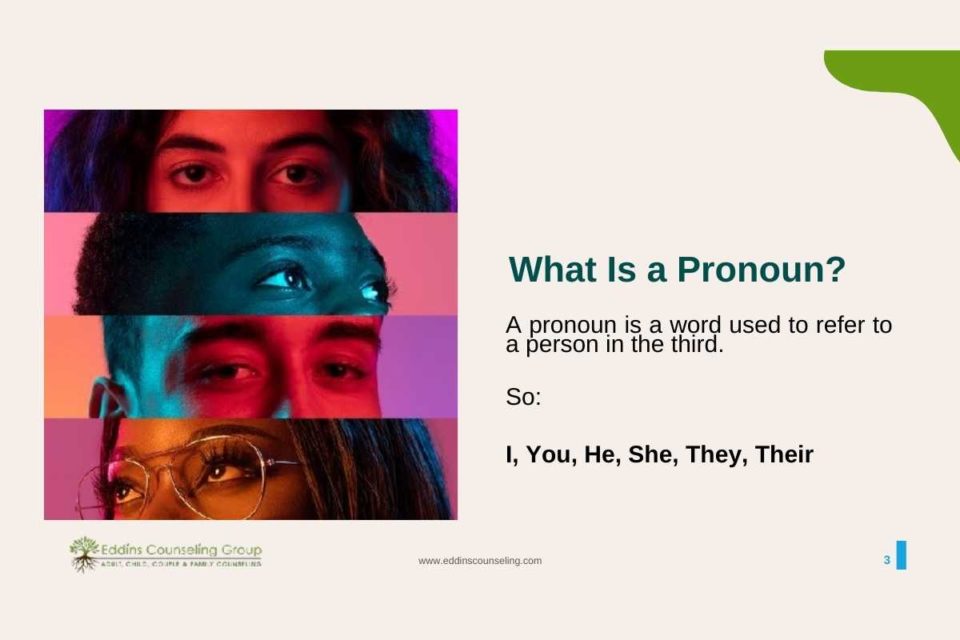
Pronouns 101
Also, we were kind of thinking about transgender folks, it’s important to understand why pronouns are so important. Oftentimes I hear a lot of challenges to pronouns within, both in society, from educators that I do when I’m doing these kinds of training, and even sometimes from parents of my trans youth that I’m counseling.
It can be very, very challenging, and hard for them to accept that their child or the individual with whom they’re working is going ahead and changing their pronouns.
What Is a Pronoun?
A pronoun is a word used to refer to a person that you’re talking about or a person talked about in the third. So: I, You, He, She, They, Their.
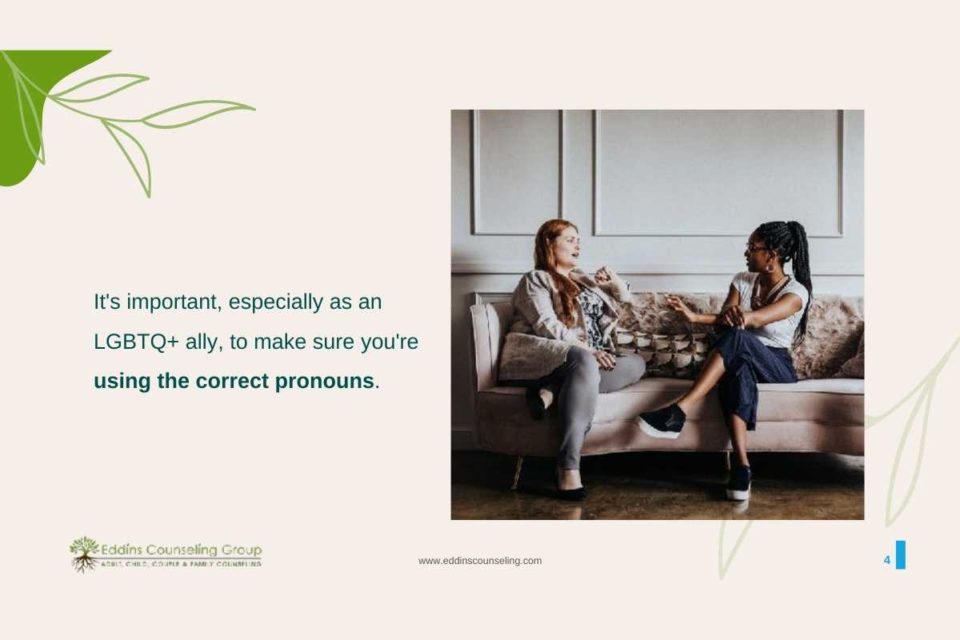
Why Do Pronouns Matter?
Why does it matter? And I want you to really think about this. How many times has someone used your name or pronouns over this past weekend? If you really take a second to think about it, I would imagine countless times, hundreds of times, probably.
Now, imagine that your pronouns were misused each and every time someone either referred to you around you or maybe they misnamed you or dead-named you when they were talking to you.
How would that feel for you to go ahead and be misgendered constantly? It’ll be cutting. It’s a really big challenge to one’s self-worth, self-esteem, and self-concept.
The reason why folks are very insistent around pronouns is that the dysphoria, the shame, and the feelings of depression and anxiety around being the standard are very, very common.
It’s important, especially as an LGBTQ+ ally, to really make sure that you’re listening to when folks correct you on the pronouns and to make sure you’re using the correct pronouns.

Create an Inclusive Environment Around Pronouns
So it’s important also as an ally to create an inclusive environment around pronouns. LinkedIn has done some really good work here in which they’ve gone ahead and included pronouns on LinkedIn profiles.
When I’m in session for the first time, and I’m meeting a client, I go ahead and introduce my pronouns myself. Or if I’m going to go ahead and do it at a meeting at work, I’m going to go ahead and highlight my pronouns there. In my email signature, I also have my pronouns.
It’s very, very important to go ahead and make sure that as an LGBTQ+ ally, you’re leading the charge and using the privilege that comes from being either heterosexual or specific gender in order to go ahead and help those that are more marginalized. Including your own pronouns, can be incredibly beneficial.
When unsure, simply ask: “What pronouns do you use?” Be cautious with the question: “What pronouns do you prefer?”, because that is not necessarily something that’s as supportive.
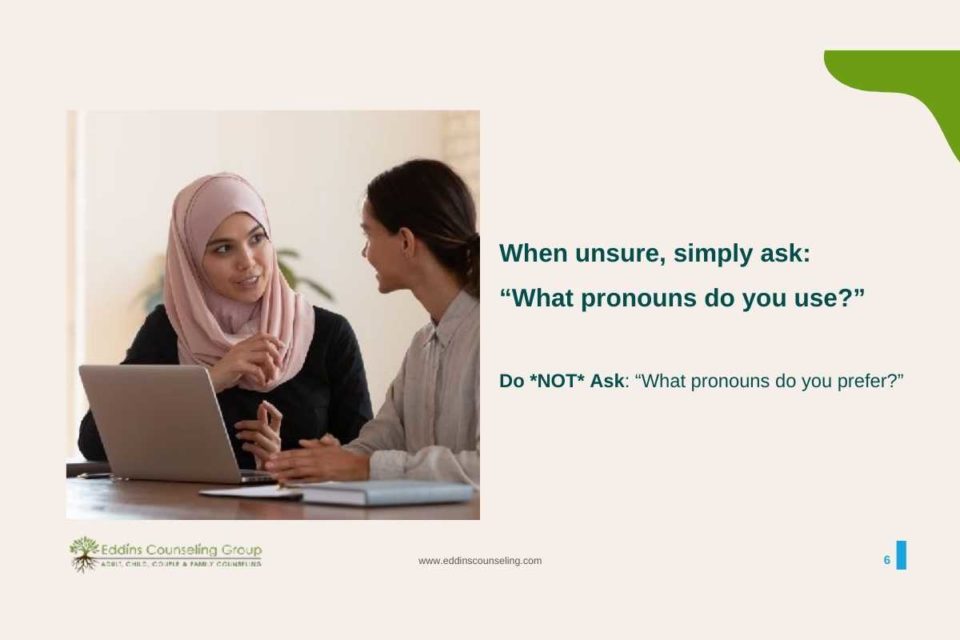
Always use pronouns unless asked not to
Someone’s come out to you, but they’ve maybe not come out to their family or their friends. You may want to understand who they’re out to already and when you can’t and can’t use the pronouns to which they’ve gone ahead and use for you. Oftentimes you can make mistakes, too. That happens.
Keep practicing!
Practice on your own outside of just the relationship with that individual, and make sure that if you do make mistake, just apologize and move forward.
You can also go ahead and assist others who are making these kinds of mistakes by gently correcting them and helping them move through a little bit easier.
Examples of Pronouns
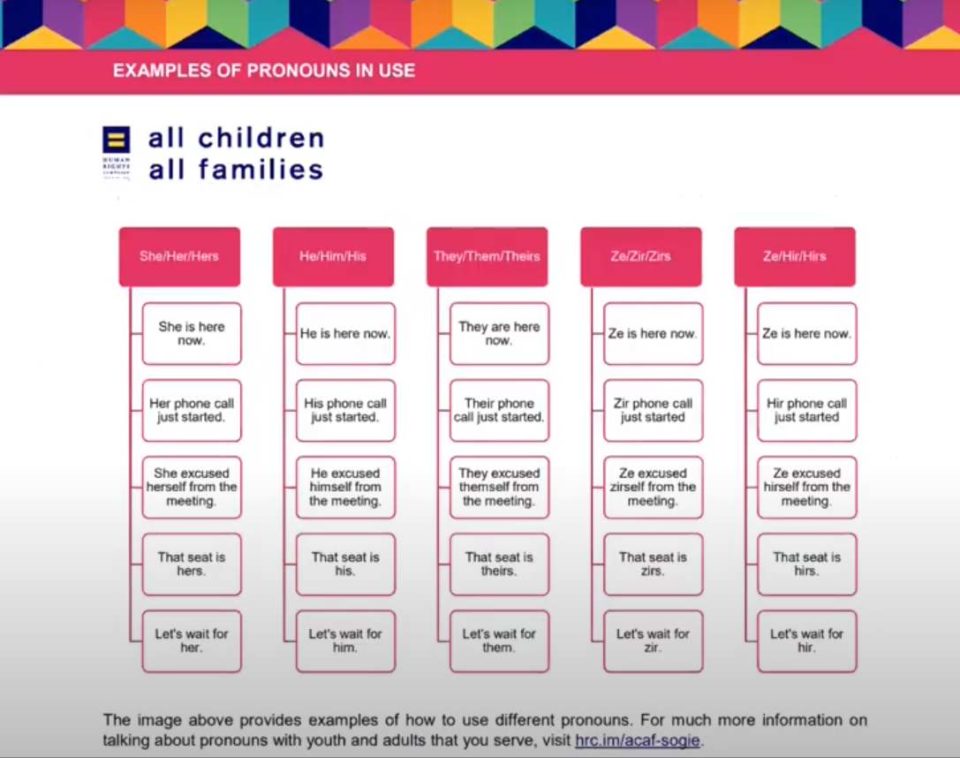
Here are some examples of different kinds of pronouns in use. Oftentimes we’re going to go ahead and see folks that identify maybe as trans or as nonbinary in particular or gender expansive, maybe gravitate a little bit more towards they/them/their pronouns.
That being said, everyone is going to be a little bit different in the way they’re comfortable. Just make sure that you go ahead and ask: “What pronouns do you use?”.
Better to go ahead and ask than not to ask and make a mistake.
Demonstrate Support for Gender Expression
Demonstrate support for gender expression. So avoid gendered phrases like “Good morning, ladies and gentlemen”. Help discuss topics that counteract common societal or gender norms like: “Boys and girls can be great athletes”.
“Colors are colors!” There are no boy or girl colors. So helping shape or change some of the ways in which gender and gender expression shape society can be really, really helpful, especially when working with gender expanses of gender nonconforming individuals.
LGBTQ+ Symbols

Symbols, because it’s also important to understand the kind of symbols that are around, particularly during Pride Month. We can see the first one, the Pride flag, originally designed. They kind of cut off the cyan and the light pink because of the expense of printing those on flags, so we typically see the traditional rainbow now. We also see the Bisexual Pride flag, Intersex Pride flag, and Labrys Lesbian Pride flag as well.
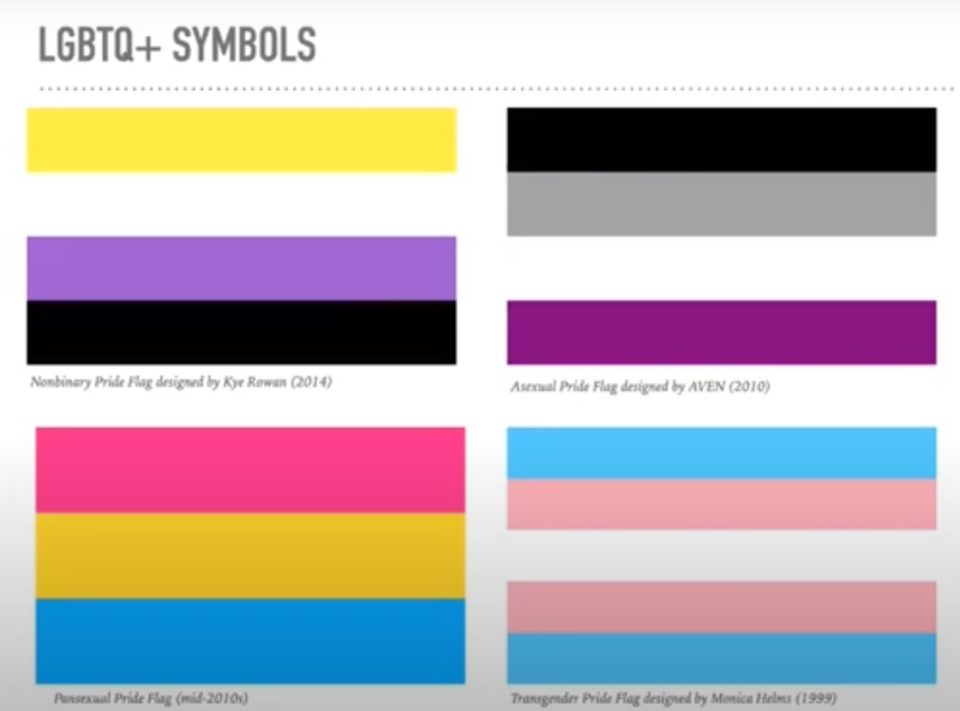
Nonbinary Pride flag, Asexual Pride flag, Pansexual and Transgender. And so oftentimes, if you see kind of a flag of any of these shades, generally, it means that that individual is a member of the LGBTQ community.

There are also some symbols that are associated with the LGBTQ community that are beneficial for you to know as an ally as well. Again, oftentimes the pink triangle is going to be used for gays in general, but it’s been kind of adopted widely by the LGBTQ community. That one’s really an important one because it was used by Nazis to identify homosexual men in concentration camps. It’s been repurposed within the community as a symbol of pride.
LGBTQ+ “Holidays”
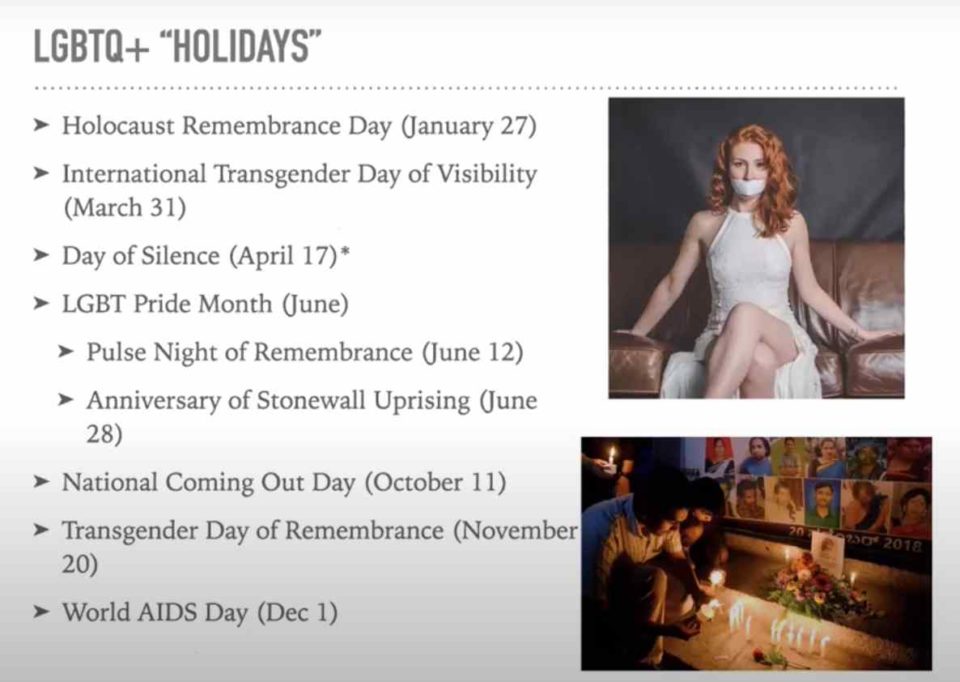
There are also LGBTQ+ holidays, or days that are really important. Pride Month is in June. We have the Pulse Night of Remembrance coming up for the post-massacre that happened in Florida. And then also in June, 28th is the anniversary of the Stonewall Uprising, which typically is when most folks celebrate a traditional day of pride.
The Houston Pride Parade generally is around that same time period. This year, of course, because of Covid, that’s going to be delayed until the fall for TBD. But oftentimes they’re still going to be a lot of celebrations and events within the pride month to just go ahead and share awareness and create a space for the community.
Stonewall Uprising
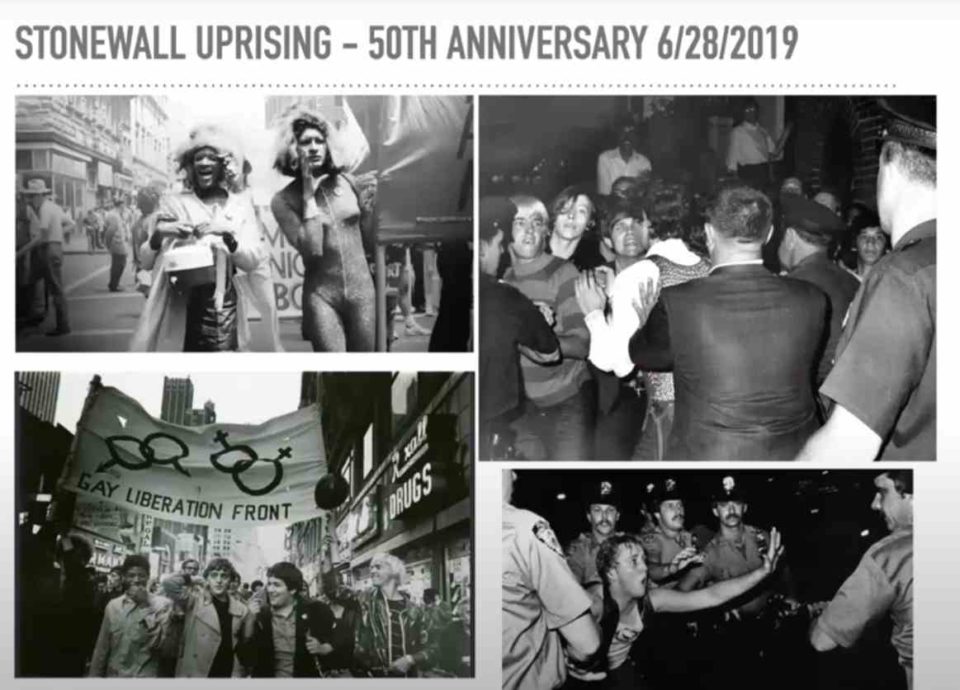
The Stonewall Uprising marked its 50th anniversary back in 2019. This is a very, very important day. Oftentimes, people credit that as the beginning of the gay liberation movement and the gay pride movement.
There were, of course, actions done before that to go ahead and resist police brutality against LGBTQ individuals, particularly trans women of color in many different spaces like in San Francisco and others, but Stonewall tends to be the one that is most well known and the one in which really did kind of start that more concrete LGBTQ pride and liberation movement.
Youth Concerns
Jumping a little bit to youth concerns, it’s important to understand that compared to their non-LGBT peers, LGBT youth report much lower levels of happiness, a higher incidence of drug and alcohol use, and also less connection to adult support during their personal problems.
Because the heterosexist insist on a gendereset society in general and feeling unsupported and not having kind of models within the family and not talked about in school, not having positive representation in the media, it’s a lot of isolation and feelings of loneliness and feelings of uncertainty of really “who I am and whether can I be accepted in this world”.
They are also two times more likely than non-LGBTQ youth to say they’ve been verbally harassed or called names at school.
So we see folks within this community often get a lot more bullying and a lot more harassment in school environments. There have been positive movements by school districts to go ahead and change this even unfortunately, in the Houston area, sometimes teachers are doing this kind of bullying and this harassment.
It’s important to understand that while there are positive movements in this direction, there’s still a lot of discrimination happening and bullying happening.
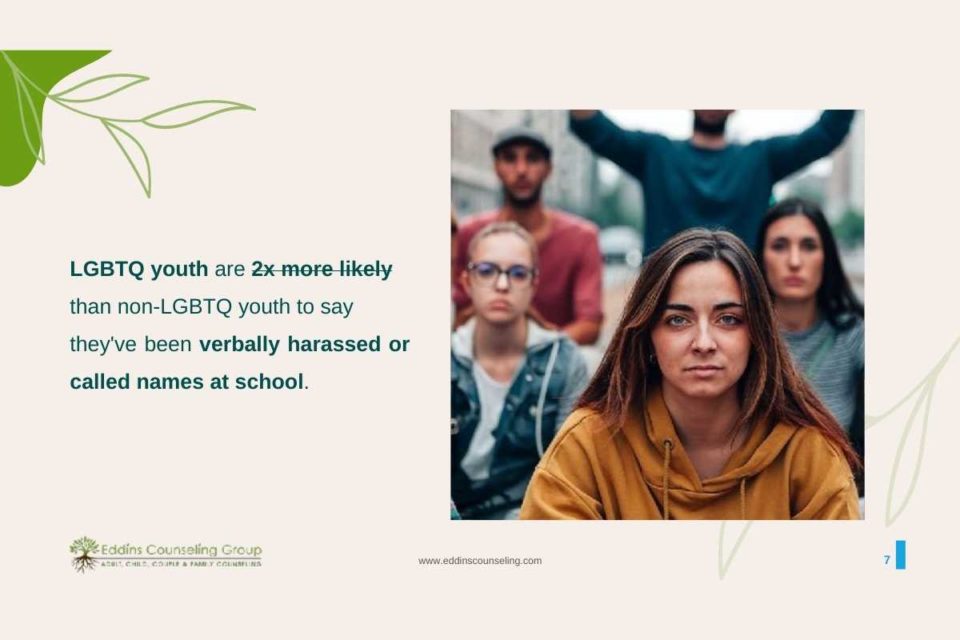
Typically, severe victimization is related to lower academic achievement among LGBTQ students, and the suicide risk is about two times higher for gay and lesbian individuals and about 40% higher for transgender individuals. And again, it’s not because of something that’s inherited with that identity, but much more about the discrimination that they face because of that identity.
Among LGBTQ youth about a third disagreed with the statement: There’s at least one adult I can talk to about my personal problem.
So oftentimes these kiddos are feeling very alone, very isolated, and very ashamed. Don’t know what this means, especially around gender identity.
There’s just not a lot of understanding of what that is and not a lot of conversation, especially in school and especially from parents, about how you can explore gender identity in a very healthy and safe way. Oftentimes that leads towards a lot of isolation, which, of course, would then increase the risk of suicide.
Mental Health

These two individuals here on the right, unfortunately, are two children that did go ahead and commit suicide, particularly after a lot of bullying, and harassment based on their LGBTQ+ identities. They often find themselves having challenges finding LGBTQ+ or LGBTQ+ inclusive therapists.
Even on the mental health side, if you’re in a rural area or if you’re an area that does not have access to a lot of good therapists in this space, it can be very, very challenging to find someone that you feel like you can really open up with, be vulnerable, and can understand your experience.
Someone that is an LGBTQ-affirming therapist and part of the community myself, I have many clients from across the state that are in very, very rural regions in which there literally is no therapist within like 80 miles of them that are LGBTQ+ knowledgeable.
It’s very important to understand that there are a lot of barriers to access because there are not a lot of folks in the community that are able to access resources as easily as those of us that may be a little bit more in the urban area like the center of Houston.
Typically about two times as likely to have mental health concerns as compared to heterosexual individuals, and higher rates of suicide ideation attempts, LGB high school students are about five times as likely to attempt suicide compared to their heterosexual peers.
About 48% of trans adults have considered suicide in the past year, compared to 4% of the population.
That’s a pretty staggering statistic when you really think about it. About half of transgender adults versus 4% of the general population.
And so it really makes you as an LGBTQ+ ally, hopefully, question what are some things that are going on in society that’s making transgender adults and specifically feel so isolated and feel so discriminated against? When you really do think of that, you can see a lot of things structurally within our society that creates a lot of barriers to acceptance and for one to go ahead and feel like they can go ahead and be their authentic selves.
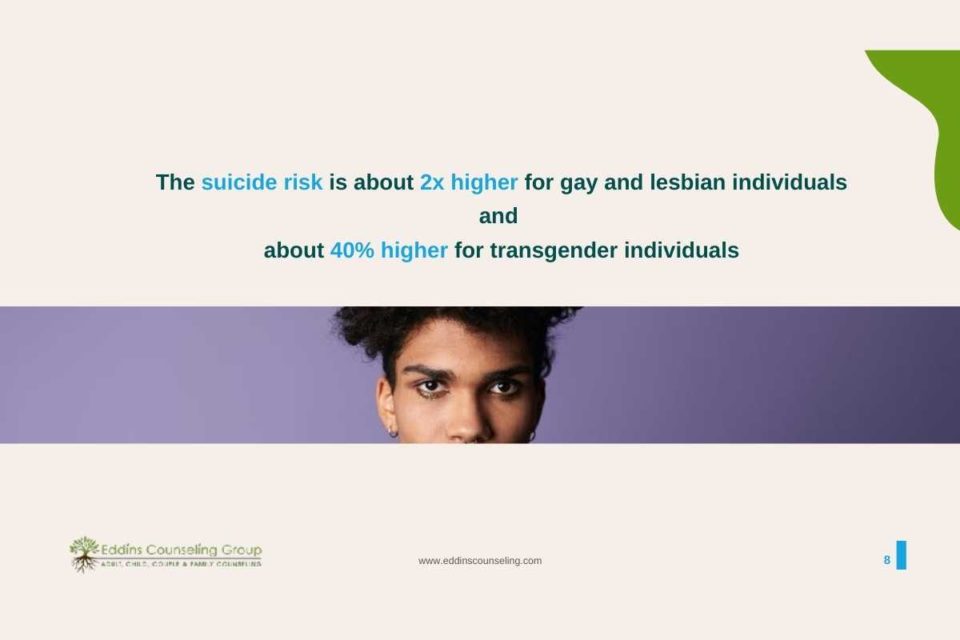
Family Concerns – Rejection
Oftentimes, there are a lot of family concerns, too, around rejection. For LGBTQ adolescents or children or even adults. I worked with folks that are maybe in their 60s, or 70s, and they never came out to their parents because they never felt safe. There was fear of that rejection. Parents made homophobic comments in the past that they just didn’t feel like they could go ahead and open themselves up.
It’s really important, especially if you have an LGBTQ child or maybe a family friend is LGBTQ and they have youth, to understand that those that face parental rejection in their teens or in their childhood are significantly more likely to have a lot of challenges, especially around suicidal ideation, depression and drug use.
Rejection of LGBTQ teens leads to a lot of homelessness.
And so you see this 43% percent there.
LGB adults who reported high rates of parental rejection in their teens were (compared to those with low or no rejection) (Pediatrics, Vol. 123, No.1):
- 8.4 times more likely to report having attempted suicide
- 5.9 times more likely to report high levels of depression
- 3.4 times more likely to use illegal drugs
- 3.4 times more likely to have had unprotected sex
Out of the homeless teen population entirety, 43% identify as LGBTQ+. And the reason as to why that is is because they’re getting running away from a really toxic home environment or they’re being kicked out. There’s a lot of parental violence or abuse based on those LGBTQ identities. And also there’s a lot of risky behavior that happens because of how are you going to survive in the streets as a teen that leads a lot of people to go ahead and do sex work or use drugs as a way to go ahead and make ends meet because there’s not a lot of support.
Chosen Family
Oftentimes you’re going to hear LGBTQ+ folks also use the term Chosen Family, very positive and uplifting. A group of people who you’re not necessarily biologically related to or legally related to, but you feel a stronger emotional bond with and consider them family.
Oftentimes I have queer folks that I work with that are closer to their chosen family than they are to their biological family. And that’s why chosen family is so important because it creates a space for those that do face the family of origin rejection, which is the FOO abbreviation. To go ahead and find a space of community in which they can go ahead and be their authentic selves and be appreciated for that.

Benefits of Allyship
- Increased knowledge and awareness
- Upholding values of justice
- Taking a positive view of others allows one to flourish and grow and
- Fosters personal development and
- Wellbeing
- Beneficial individual relationships
- Community belonging
- Educating Others
- Being a role model
- Using social privilege
So kind of shifting gears a little bit, talking about some of the benefits of Allyship. As an LGBTQ+ ally trying to attend today, learning a little bit more, there are things that happen for you that are actually beneficial in being an LGBTQ+ ally.
You increase your knowledge and awareness, hopefully, have a value of justice or compassion or empathy and altruism.
That may be something that’s aligned with your own values. And by being an LGBTQ+ ally, you’re upholding that value.
You’re taking a positive view of others, and that allows you yourself to go ahead and flourish and foster positive development.
You may go ahead and increase beneficial individual relationships, particularly with the LGBTQ+ folks, have a greater sense of community belonging, and enjoy the process of educating others, and being a role model, particularly if you’re maybe the only one in your social circle or in your friend group that you know is someone that is supportive of the LGBTQ+ community, you can be a leader to go ahead and make a positive change not only within yourself but within the world, around you, and the community, around you.
You also get to go ahead and use your social privilege, and so again, that’s someone that may identify as straight or may identify as cisgender, it can be very, very beneficial for you to be able to use that privilege and use that platform that you have to be able to speak out and take a stand for something that’s allowing your values.
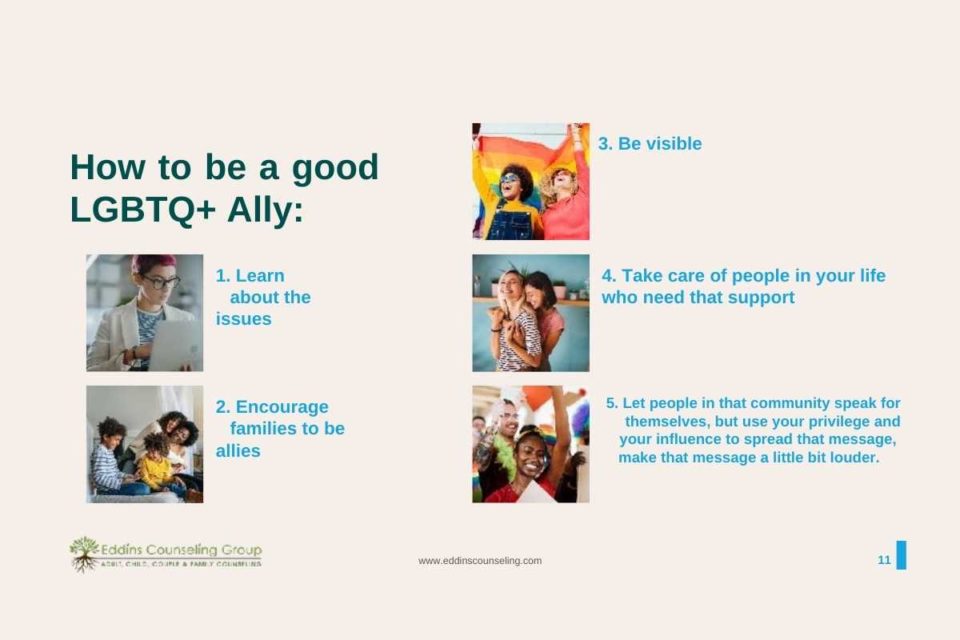
Qualities of an LGBTQ+ ally
So I want to kind of jump into a little bit about the qualities of being an ally, because out of anything in this presentation today, this is the thing I would hope that you’re taking the weight the most.
To be an LGBTQ+ ally, you really need to develop an understanding of sexual orientation, heterosexism, and the challenges facing LGBTQ people.
Have a good understanding of gender identity and gender expression and are comfortable with your own. Oftentimes, if you’re straight or cisgender, you may not have ever had the opportunity to really take a step back and explore:
- How did I know I was straight?
- When did they find out I was straight?
- What was the first time that I had a sexual attraction to some of the opposite gender as me?
- When did I really become comfortable with my gender identity?
- How did I get a sense of my own maleness or femaleness and what did that happen?
You know, oftentimes because it’s the norm, it’s just something that we never really actively think about. As an LGBTQ+ ally, it’s very important for you to ask yourself these sorts of questions.
Also, someone committed to personal growth, even if that growth requires sitting with discomfort. You know, oftentimes as an LGBTQ+ ally, as we’re talking through this, memories may come back of times in which you may have something said, something that was offensive to another person, or maybe you learned a new term today that you used inappropriately in the past.
Well, that’s OK! It’s important for you to be able to reflect upon that and understand: “Oh, that may have been challenging and hurtful. How can I go ahead and move forward in a space that won’t necessarily cause that same harm to others?”
We don’t grow from being stagnant. We grow from a challenge, we grow from discomfort. So that discomfort is important.
Expect to make some mistakes, but do not use them as an excuse for non-action. We all make mistakes from time to time. But just because you make a mistake doesn’t mean that you shouldn’t actively try to correct that and work through that.
Know that in empowered LGBTQ+ ally relationships, the persons in the non-oppressed role initiate the change toward personal, institutional, and societal justice.
If you’re thinking of someone who is triple marginalized, like a trans woman of color, they do not have the same privilege as a white, straight male ally. It should be the allies’ job to go ahead and really take that role to change society, to change the institution, because they have more privilege, and more power to be able to do so.
Are aware that the coming out process and realize it’s not a one-time event. It’s a unique process that brings a lot of challenges and oftentimes the challenges are minimized and not understood. “When you came out once, it must be easy for you now.” Why would that be the case? Everyone’s different.
Coming out at work, maybe very different from coming out to family and friends.
Oftentimes those minimizations become very, very hard for that individual. As an LGBTQ+ ally, recognizing that and being able to validate those concerns is very important. Understand that LGBTQ people receive the exact same messages about homosexuality and bisexuality as everyone else. And therefore, they’ll have to deal with some internalized homophobia and internalized heterosexism from time to time in their lives.
The same thing, understand that transgender and gender-non-conforming people receive the same messages about being cisgender that everyone else and thus have to do with internalized transphobia and cisgenderism.
It’s also important to recognize the risks of coming out and the challenge to that internal oppression and to challenge that within society.
If you’re really thinking about a lot of the anti-LGBTQ and particularly the trans legislatures that have happened during the legislative cycle, particularly in Texas.
- What would it be like for trans youth to go ahead and see an entire legislative body spending a lot of time and money and resources to ban them from participating in sports?
- What would that feel like for you as a child?
So, it’s hard to go ahead and imagine adults in the society that you’ve elected as governors, senators, and representatives to go ahead and really create laws that are directly targeting you for wanting to go ahead and play a sport.
It’s also important for allies to understand basic information about AIDS and HIV specifically to address missing information.
Even though HIV and AIDS are something that is not just within the LGBTQ+ community, but affects all of us within the world, oftentimes there’s a lot of misinformation and myths within the LGBTQ+ population.
It’s important to recognize that: “I need to do some research and do a better understanding of this”, and “I need to go ahead and challenge those sorts of misinformation and myths, whenever I’m presented with them”.
Also, bring a sense of community with that LGBT people to teach us the importance of outreach to others. Oftentimes as an LGBTQ+ ally, we want to be able to go ahead and be active in that. I oftentimes think of allyship as a verb because it’s something that we need to be very active on.
You can see parents back in the 50s and the 60s really supporting their LGBTQ+ children at a time in society in which that was really uncommon. We can see qualities of allyship throughout history, which is very, very important.
How To Be an LGBTQ+ Ally
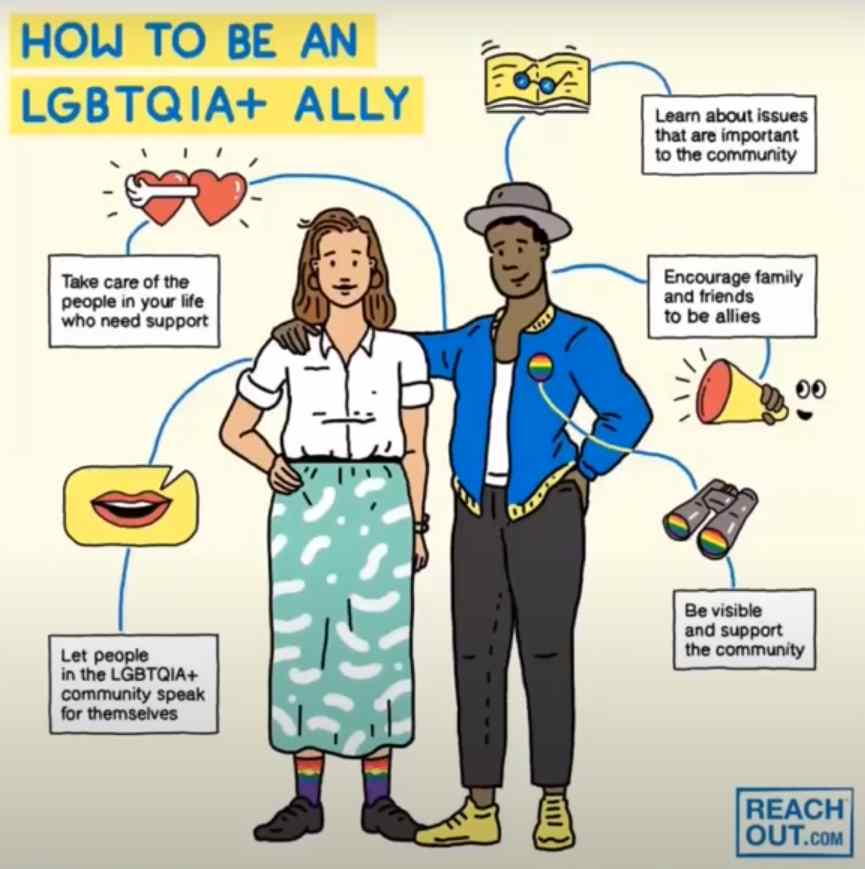
I like this little graphic, it’s quite nice. It’s a little quick reminder of how to be a good LGBTQ+ Ally, learn about the issues, encourage families to be allies, be visible, take care of people in your life who need that support, and let people in that community speak for themselves, but use your privilege and your influence to spread that message, make that message a little bit louder.
National Resources – Parents & Families
So I want to cover some resources as well because it’s important as an LGBTQ+ Ally to know what are some resources out there, either for yourself as an ally or just for folks that you may need some resources.
PFLAG
PFLAG is a wonderful organization. They have chapters all across the country. They have several chapters in Texas and a big one in Houston.
So if you know any people who are lesbian, gay, bisexual, transgender, and queer with families, friends, and allies, this organization is committed to advocating equality through its mission of support, education, and advocacy.
As an LGBTQ+ Ally, you may feel very isolated, maybe you don’t know any other allies in my community.
Well, I encourage you to join PFLAG, find a great way to go ahead and meet other allies, a great way to go ahead and have some positive impact in a larger organization that’s very, very supportive and has been around for decades.
Human Rights Campaign
Human Rights Campaign is the largest civil rights organization working to achieve equality for LGBTQ Americans. And they have a lot of really beneficial research on their website around statistics, information, policy proposals, and data.
So if there’s ever a piece of information that you’re trying to seek out and understand more, check out the Human Rights Campaign website. They have a very, very good one that has a lot of information.
Gender Spectrum
Gender spectrum is also a really wonderful organization. Their goal is to create a gender-inclusive world for all children and youth.
They help families, organizations, and institutions increase their understanding of gender. Also, they consider the implications of evolving views have for each of us.
They do a lot of really wonderful work in both educational institutions and organizations and within individuals to go ahead and help out gender expansive and maybe gender non-binary, transgender children and youth.
TransYouth Family Allies
TransYouth Family Allies is also a wonderful one that provides a lot of education and service. And so these can be good ones to go ahead and check out.
Family Equality Council
Family Equality Council is also a great one, helps connect and support and represent millions of parents who are LGBTQ and their children.
If you’re working or you have friends that are LGBTQ parents themselves, they may feel a little bit isolated or uncertain, Family Equality Council can be a great place for getting connected.
LGBTQ National Help Center
There’s also the LGBTQ National Help Center.
It’s a non for profit organization that’s dedicated to meet those needs. And so that can be a great resource to go ahead and share with others.
Trevor Project
One other that I didn’t include here, that’s really good specifically for LGBTQ youth is the Trevor Project. It’s a very helpful one. They also have a crisis hotline that they operate.
If you know any LGBTQ youth in distress and need some support, I encourage you to share the Trevor Project.
They have a crisis line that can be great in times of suicidal ideation, self-harm, or any kind of crisis.
Houston-Area Resources
Houston also has some really great resources as well.
Montrose Center
The Montrose Center in the Houston area is wonderful. They do a lot of community outreach and involvement.
They have low-cost and sliding-scale counseling, free support groups, and also two different types of organizations for youth. So they have Hatch Youth, particularly those that are between 13 and 20.
These working hours may maybe a little bit different now because of Covid and they may be shifted to virtual. And so do not quote me on these times.
Be sure to check Montrose Center’s website.
They also have Hatch Youth Jr. for both younger children and preteen ages, as well as parents and guardians too.
This can be a great way if you have an LGBTQ child yourself and they don’t really know anyone else. Way to go ahead and meet others and get supported and be empowered within a positive LGBTQ-affirming space.
Nest
Nest is also a very important citywide effort right now to go ahead and prevent homelessness among adolescents and young adults who do identify as LGBTQ.
It’s currently coordinated through the Montrose Center, but still, a very good organization to know about.
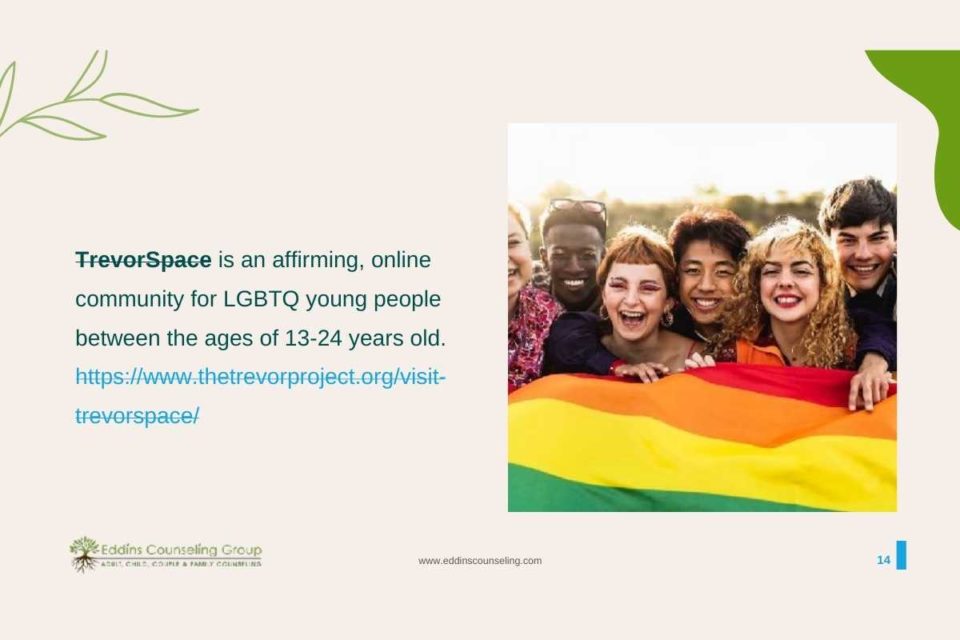
Tony’s Place
Tony’s place is also a good drop-in center for LGBTQ youth up to the age of twenty five who are unstably housed or may be experiencing homelessness.
They’ll be able to provide a lot of immediate needs and life skills. So hot meals, shower, Wi-Fi, use of computers, mail service if they’re homeless, clothing, backpacks, hygiene kits, etc.
When in doubt, definitely check Montrose.
There are a lot of other LGBTQ organizations in our community that are quite helpful for those experiencing homelessness.
Open Gate Ministries
We also have Open Gate Ministries as well. That’s a program focused on more young adults, 18-30 homeless adults of any sort, sexual orientation, or gender identity.
So there is a specific focus on the LGBTQ population. They’re having a very difficult time at shelters or agencies.
At times, shelters and agencies for homeless individuals may be a little bit more religious-focused.
And sometimes, you know, religion may not be the most affirming of the LGBTQ individual especially. They may have some religious trauma.
And so it’s important to understand that some LGBTQ-specific resources can be helpful versus just sending them to the local homeless shelter, which may be not as affirming or accepting of their identities.
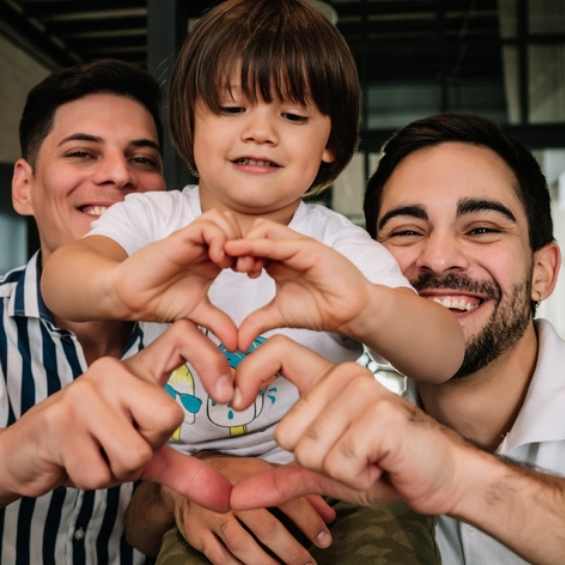
Houston-Area LGBTQ+ Affirming Faith Organizations
There are also some LGBTQ-affirming faith organizations in the Houston community that are really good to understand and know.
Oftentimes I see LGBTQ individuals and families that may be coming from religious backgrounds and maybe their religious background to the church to which they were accustomed and grew up may not be the most LGBTQ-affirming organization.
It’s important to understand that spirituality is an important part of life. Folks that are LGBTQ and maybe in an LGBTQ-affirming type of faith community, still may go ahead and find a need to have a faith community there.
These are ones that are very affirming and LGBTQ-specific to go ahead and create a safe and inclusive environment for them to go ahead and explore their spirituality and their religious beliefs.

Questions
So now I want to go ahead and take some time for questions. I’m going to stop my share and see what kind of questions we may have had throughout. Any questions or thoughts that you have based upon the things that we’ve covered?
“I find it interesting, I actually save some training at my job and I identify as Bi. One of my children identifies as Pan and has gender fluidity. I am just intrigued by how much access we have now that we didn’t when I was a kid. I think we are doing this generation a service, whereas we did generations previously a disservice. And so I thank you for doing things like this, but I’m also just glad that, you know, you can go to the Internet now and sort through stuff and you can find what you need, what you’re looking for and you can find communities in ways that we couldn’t when I was a kid. And it’s amazing. So so thank you for doing what you do. And I’m just glad things like this do exist now.”
Especially when thinking about the community, and especially LGBTQ youth. I mentioned Trevor Project and they actually have a social networking community for specifically LGBTQ youth called, Trevor Space. I got a lot of LGBTQ youth clients in isolated geographic regions that found a great sense of community there as well.
But, yes, you’re very much right.
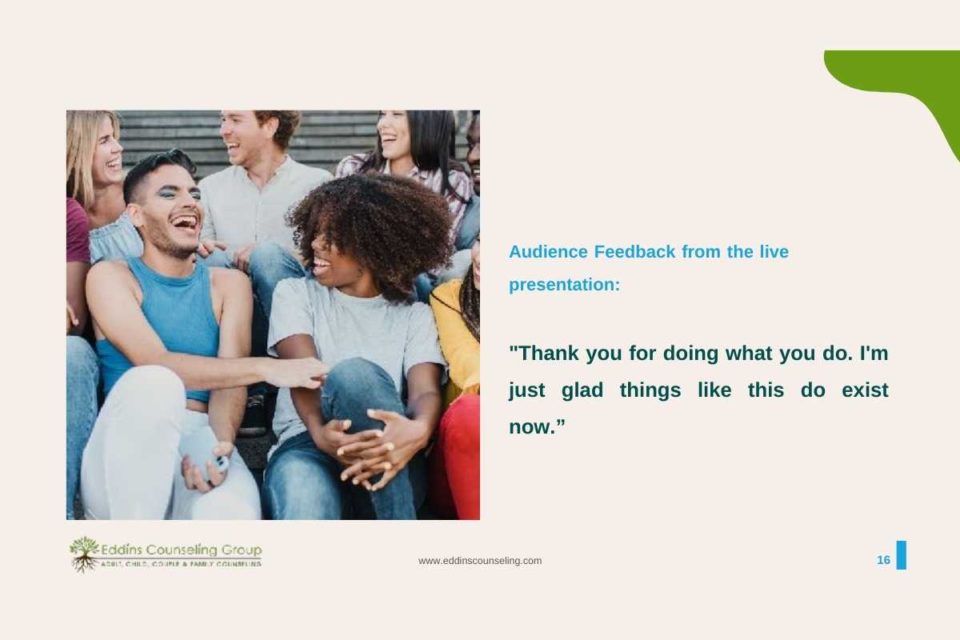
I think that from past generations in which we never really talked about these things and it wasn’t really something that was ever encouraged to explore.
It definitely was a disservice, both for, I think, society at large and also those within the community. And hopefully, this is something that’s uplifting as you hear this, but I’ve actually had quite a bit of school districts, especially within the Houston area where I’ve done some really deep training on this topic, specifically to teach school counselors how to support LGBTQ youth.
More and more school districts keep on reaching out for this kind of support and training. It really is quite uplifting to my heart to see this, because even when I was in high school more than a decade ago, that was nothing. And there wasn’t even mention of different sexual orientations in our health class. So, it’s ever-changing and ever-evolving. But I do agree with you completely that things are moving in a much more positive direction. And I hope that that can continue.
Thank you so much for your time tonight.
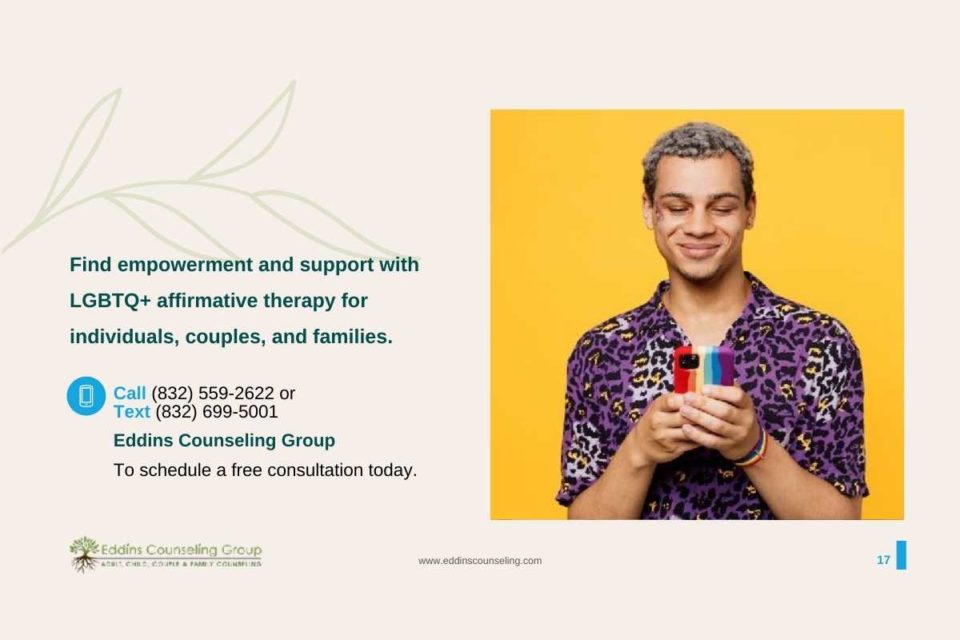
Next Steps
Find empowerment and support with LGBTQ+ affirmative therapy for individuals, couples, and families. Call today for LGBTQ+ Counseling or LGBTQ Couples Therapy.
Call us at (832) 559-2622 or text us at (832) 699-5001
Other Resources to Consider:
7 Mood-Boosting Tips
Get instant access to your free ebook.

